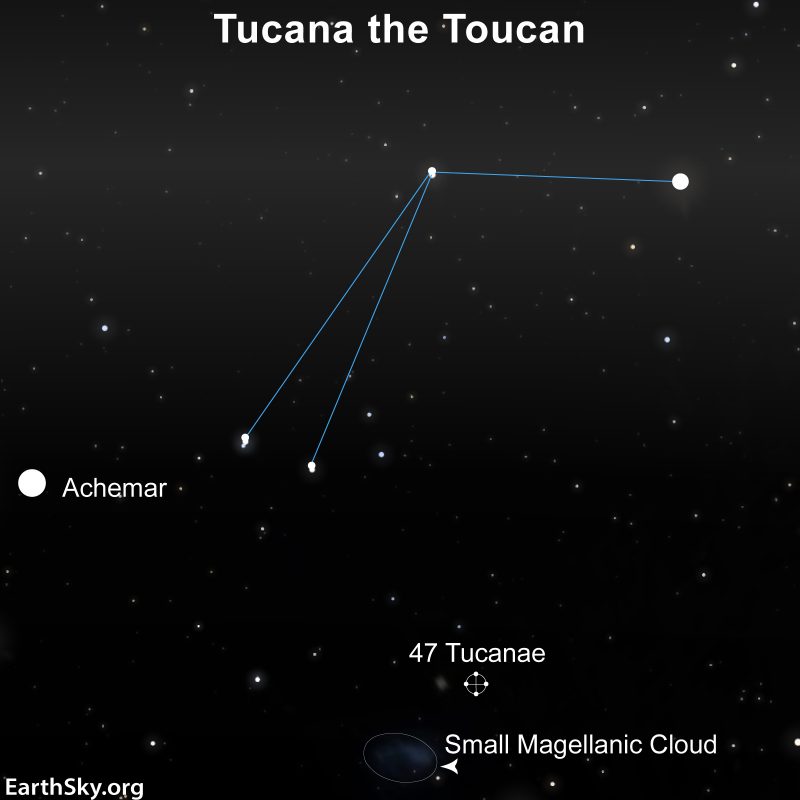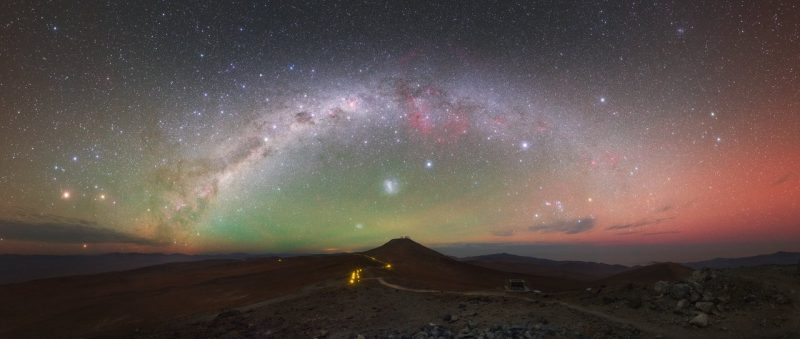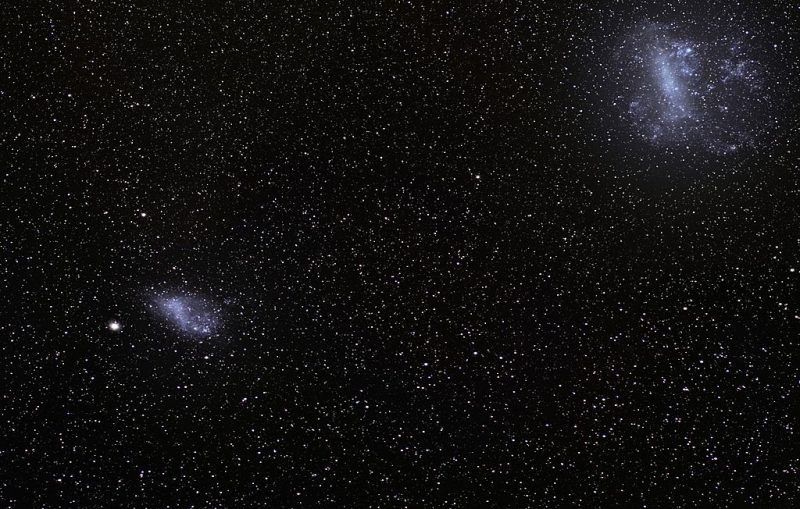
Lucky Southern Hemisphere observers get to see something that many northerners never see: the Magellanic Clouds. The Large and Small Magellanic Clouds are satellite galaxies of the Milky Way. As some of the closest galaxies to our home galaxy, they stand out as big, misty blobs of light under dark skies. Scientists estimate the Small Magellanic Cloud contains around 3 billion stars, while the Large Magellanic Cloud houses some 30 billion stars.
History usually credits 15th-century Portuguese voyager/astronomer Ferdinand Magellan with “discovering” these hazy star-clouds. And, in later years, the Clouds became known by his name. But, in addition to Magellan, many early navigators used these two small galaxies to find their way across southern oceans. And they were always noticeable in the sky to the people of the Southern Hemisphere, and so they figured in early southern legends and myths.
The Magellanic Clouds from the Southern Hemisphere
If you want to see the Magellanic Clouds, you have to head south. They’re not visible north of about 17 degrees north latitude. If you are in the Southern Hemisphere, you can see these satellite galaxies any night of the year because they’re south circumpolar, that is, they’re close enough to the South Celestial Pole that they never set.
The Large Magellanic Cloud is one of the closest galaxies to us at about 160,000 light-years away. It’s about 40,000 light-years closer than the Small Magellanic Cloud.
EarthSky 2022 lunar calendars now available! They make great gifts. Order now. Going fast!
How to see the Magellanic Clouds
The Large Magellanic Cloud is easier to spot than the Small Magellanic Cloud, but they both require dark skies.
The Large Magellanic Cloud shines at magnitude 0.9. Keep in mind that it’s stretched out over an area of sky about 9 by 11 degrees. A star of that magnitude would appear very bright because of its pinpoint source of light, but for the Large Magellanic Cloud, its diffuse, spread-out light means it appears as a hazy smudge on the sky.
The Large Magellanic Cloud lies in both the constellations Dorado and Mensa. Draw a line from Sirius past the right side of Canopus to find it.

The Small Magellanic Clouds shines at magnitude +2. Its brightness is spread over about about 13 square degrees of sky. You can find it in the southeast corner of the constellation Tucana the Toucan.

The Clouds in myth
In the Southern Hemisphere, Australian Aborigines, the Maori people of New Zealand and the Polynesian people of the South Pacific were familiar with both the Large and Small Clouds. They used them as navigational markers during their oceanic expeditions. They considered these hazy star-clouds predictors of the winds. The website OzSky.org explains:
Many tribes of Australian Aboriginals have ‘dreamtime stories,’ which they have passed down from generation to generation, to explain the universe as they perceive it. One such legend describes the Clouds as the campfires of an old couple, the Jukara. The Jukara relied on other star people to supply them with fish and lily bulbs caught in the Milky Way to survive. The old couple cooked the food over their campfire, which was the star Achernar. The Large Cloud represented the old man while the Small Cloud was the old woman.
Another myth comes from South Africa. The nearby constellation Mensa (“Table”) got its name from South Africa’s Table Mountain. One story says that the Large Magellanic Cloud is a puff of smoke from a pipe-smoking contest held on the mountain.
In history, Al Sufi, the Persian astronomer, described the Large Magellanic Cloud in his Book of Fixed Stars in AD 964. He called it Al Bakr, describing it as the White Ox of southern Arabia.

Science of the Magellanic Clouds
Henrietta Swan Leavitt – famous for her work on the Cepheid variable stars – studied the Large and Small Magellanic Clouds from Harvard College Observatory in Southern Peru. In the early 1900s, she published her work on variable stars in the Small Magellanic Cloud, famously showing the relationship between the periods (cycles) of the stars’ variability and their luminosities. Her study was titled 1777 variables in the Magellanic Clouds. The period-luminosity relationship later became a reliable gauge for astronomers trying to parse the riddle of star and galaxy distances.
Astronomers believe that the Large and Small Clouds formed around the same time as our Milky Way, some 12 to 13 billion years ago. Due to their repeated interaction with our larger Milky Way galaxy, it’s thought that great galactic tides might have caused their irregular shape.
The ongoing Dark Energy Survey found a dark stream of interacting matter between the Large and Small Magellanic Clouds. Simulations performed by a team of scientists at the University of Arizona suggested that the two galaxies might be interacting with each other and might eventually merge.

Bottom line: The Large and Small Magellanic Clouds are two of the closest galaxies to the Milky Way. They can be seen without optical aid from southern skies.
The post The Magellanic Clouds, our galactic neighbors first appeared on EarthSky.
from EarthSky https://ift.tt/3Iwfs1b

Lucky Southern Hemisphere observers get to see something that many northerners never see: the Magellanic Clouds. The Large and Small Magellanic Clouds are satellite galaxies of the Milky Way. As some of the closest galaxies to our home galaxy, they stand out as big, misty blobs of light under dark skies. Scientists estimate the Small Magellanic Cloud contains around 3 billion stars, while the Large Magellanic Cloud houses some 30 billion stars.
History usually credits 15th-century Portuguese voyager/astronomer Ferdinand Magellan with “discovering” these hazy star-clouds. And, in later years, the Clouds became known by his name. But, in addition to Magellan, many early navigators used these two small galaxies to find their way across southern oceans. And they were always noticeable in the sky to the people of the Southern Hemisphere, and so they figured in early southern legends and myths.
The Magellanic Clouds from the Southern Hemisphere
If you want to see the Magellanic Clouds, you have to head south. They’re not visible north of about 17 degrees north latitude. If you are in the Southern Hemisphere, you can see these satellite galaxies any night of the year because they’re south circumpolar, that is, they’re close enough to the South Celestial Pole that they never set.
The Large Magellanic Cloud is one of the closest galaxies to us at about 160,000 light-years away. It’s about 40,000 light-years closer than the Small Magellanic Cloud.
EarthSky 2022 lunar calendars now available! They make great gifts. Order now. Going fast!
How to see the Magellanic Clouds
The Large Magellanic Cloud is easier to spot than the Small Magellanic Cloud, but they both require dark skies.
The Large Magellanic Cloud shines at magnitude 0.9. Keep in mind that it’s stretched out over an area of sky about 9 by 11 degrees. A star of that magnitude would appear very bright because of its pinpoint source of light, but for the Large Magellanic Cloud, its diffuse, spread-out light means it appears as a hazy smudge on the sky.
The Large Magellanic Cloud lies in both the constellations Dorado and Mensa. Draw a line from Sirius past the right side of Canopus to find it.

The Small Magellanic Clouds shines at magnitude +2. Its brightness is spread over about about 13 square degrees of sky. You can find it in the southeast corner of the constellation Tucana the Toucan.

The Clouds in myth
In the Southern Hemisphere, Australian Aborigines, the Maori people of New Zealand and the Polynesian people of the South Pacific were familiar with both the Large and Small Clouds. They used them as navigational markers during their oceanic expeditions. They considered these hazy star-clouds predictors of the winds. The website OzSky.org explains:
Many tribes of Australian Aboriginals have ‘dreamtime stories,’ which they have passed down from generation to generation, to explain the universe as they perceive it. One such legend describes the Clouds as the campfires of an old couple, the Jukara. The Jukara relied on other star people to supply them with fish and lily bulbs caught in the Milky Way to survive. The old couple cooked the food over their campfire, which was the star Achernar. The Large Cloud represented the old man while the Small Cloud was the old woman.
Another myth comes from South Africa. The nearby constellation Mensa (“Table”) got its name from South Africa’s Table Mountain. One story says that the Large Magellanic Cloud is a puff of smoke from a pipe-smoking contest held on the mountain.
In history, Al Sufi, the Persian astronomer, described the Large Magellanic Cloud in his Book of Fixed Stars in AD 964. He called it Al Bakr, describing it as the White Ox of southern Arabia.

Science of the Magellanic Clouds
Henrietta Swan Leavitt – famous for her work on the Cepheid variable stars – studied the Large and Small Magellanic Clouds from Harvard College Observatory in Southern Peru. In the early 1900s, she published her work on variable stars in the Small Magellanic Cloud, famously showing the relationship between the periods (cycles) of the stars’ variability and their luminosities. Her study was titled 1777 variables in the Magellanic Clouds. The period-luminosity relationship later became a reliable gauge for astronomers trying to parse the riddle of star and galaxy distances.
Astronomers believe that the Large and Small Clouds formed around the same time as our Milky Way, some 12 to 13 billion years ago. Due to their repeated interaction with our larger Milky Way galaxy, it’s thought that great galactic tides might have caused their irregular shape.
The ongoing Dark Energy Survey found a dark stream of interacting matter between the Large and Small Magellanic Clouds. Simulations performed by a team of scientists at the University of Arizona suggested that the two galaxies might be interacting with each other and might eventually merge.

Bottom line: The Large and Small Magellanic Clouds are two of the closest galaxies to the Milky Way. They can be seen without optical aid from southern skies.
The post The Magellanic Clouds, our galactic neighbors first appeared on EarthSky.
from EarthSky https://ift.tt/3Iwfs1b

Aucun commentaire:
Enregistrer un commentaire